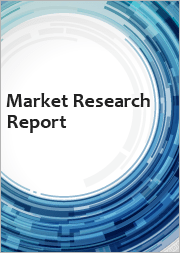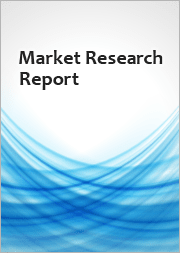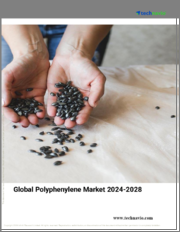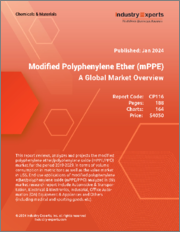
|
시장보고서
상품코드
1406088
세계의 폴리페닐렌 시장 : 점유율 분석, 산업 동향 및 통계, 성장 예측(2024-2029년)Polyphenylene - Market Share Analysis, Industry Trends & Statistics, Growth Forecasts 2024 - 2029 |
||||||
폴리페닐렌(Polyphenylene) 시장 규모는 2024년에 34억 7,000만 달러로 추정·예측되고, 2029년에는 43억 3,000만 달러에 달할 것으로 예상되며, 예측 기간 중(2024-2029년)의 CAGR은 4.51% 이상으로 성장할 것으로 예측됩니다.

폴리페닐렌 시장은 COVID-19 팬데믹에 의해 생산과 이동이 정체되어 전기 및 전자, 운수 등 업계가 봉쇄 조치 대책과 경제적 혼란에 의해 생산 지연을 강요받는 등 부정적인 영향을 받았습니다. 현재 시장은 팬데믹에서 회복하고 있습니다. 시장은 2022년 팬데믹 이전 수준에 이르며 앞으로도 안정된 성장이 예상됩니다.
전기 및 전자산업에서 폴리페닐렌의 사용량 증가와 하이브리드 전기자동차 수요 증가가 조사 대상 시장 성장을 가속하는 요인이 되고 있습니다.
반면에, 폴리페닐렌은 다른 기존 재료에 비해 대체품이 입수하기 쉽고, 비용이 높은 것이 시장 성장을 제한하는 주요 요인이 되고 있습니다.
또한, 5G 회로 기판에서 폴리페닐렌의 새로운 용도는 조사 시장에 유리한 기회로 작용할 것으로 예상되는 주요 요인입니다.
아시아 태평양이 시장을 독점해 중국, 일본, 한국, 인도의 소비가 최대가 될 전망입니다.
폴리페닐렌 시장 동향
자동차 및 운송 분야로부터 수요 증가
- 폴리페닐렌은 폴리페닐렌 설파이드(PPS), 폴리페닐렌 옥사이드(PPO), 폴리페닐렌 에테르(PPE) 등 유도체로 가공됩니다. 폴리페닐렌 유도체는 더 높은 온도 안정성이 요구되는 전기자동차 부품에 선호됩니다.
- 최근 PPS는 금속, 방향족 나일론, 페놀 폴리머 및 벌크 성형 화합물을 대신하여 다양한 엔지니어링 자동차 부품에 채택되었습니다.
- 폴리페닐렌 유도체는 고온에 노출되는 자동차 부품에 이상적인 선택입니다. 이는 경량이지만 높은 강도를 제공할 수 있습니다. 이는 전기 커넥터, 점화 시스템, 조명 시스템, 연료 시스템, 하이브리드 자동차용 인버터 부품, 피스톤 등 자동차 부품에 사용됩니다.
- OICA(Organisation Internationale des Constructeurs d'Automobiles)에 따르면 2022년에는 전 세계 8,502만대의 자동차가 생산되어 2021년 대비 6%의 성장률을 기록했습니다.
- 중국은 세계 최대의 자동차 제조업체입니다. 일본의 자동차 부문은 제품의 진화를 도모하고 있으며, 환경 문제에 대한 관심이 높아지면서 배기 가스를 최소화하면서 연비를 확보하는 제품의 제조에 주력하고 있습니다.
- OICA에 따르면 2022년 동국의 자동차 생산 대수는 2,702만 1,000대, 자동차 판매 대수는 2,686만 4,000대에 달하고, 전년대비 3.4% 증가, 2.1% 증가했습니다.
- 또한 세계 전기자동차 시장은 크게 확대되고 있으며, 이는 조사 대상 시장에 이익을 줍니다. 예를 들어 2022년에는 배터리 전기자동차(BEV)와 플러그인 하이브리드 전기자동차(PHEV)가 전 세계에서 약 1,050만대 판매되었으며 전년 677만대에 비해 55%의 성장률을 보이고 있습니다.
- 이상과 같은 요인에 의해 자동차 및 운송 분야에서 폴리페닐렌 수요가 대폭 증가해, 시장 세분화의 성장이 촉진될 것으로 예상됩니다.

아시아 태평양이 시장을 독점
- 폴리페닐렌의 최대 시장은 아시아 태평양입니다. 중국, 일본, 한국, 인도 등 국가에서는 자동차 및 운송, 전기 및 전자 등 산업이 성장하고 있기 때문에 폴리페닐렌 수요가 증가하고 있습니다.
- 아시아 태평양에서는 각국 정부가 전기자동차 도입 및 전기자동차 제조 인프라 확대를 위한 호의적인 정책을 채택하고 있습니다. 이는 예측 기간 동안이 지역의 전기자동차 시장에 큰 자극을 줄 것으로 예상됩니다.
- 중국 정부의 정책 개발에는 새로운 내연 기관차 제조 공장에 대한 투자 제한과 2025년까지 소형 승용차의 평균 연비를 단축하겠다는 제안이 포함됩니다.
- 아시아 국가의 생활수준이 향상되고 있는 것도 전기자동차와 하이브리드차의 이용에 대한 사람들 인식이 높아지고 있습니다.
- 아시아 태평양은 중국, 일본, 한국, 말레이시아 등 국가들이 공헌하는 전기 및 전자기기의 세계 생산지이기도 합니다. 인도는 또한 아시아에서 전자 제품의 제조 기지로 부상하고 있습니다. 이와 같이 확립된 산업은 이 지역의 폴리페닐렌과 그 유도체 수요를 끌어올릴 것으로 예상됩니다.
- 이와 같이 전기 및 전자산업에서 사용량 증가와 응용범위의 확대는 시장 성장을 가속할 것으로 예상됩니다. 전자 분야에서 중국 제조 업체는 국제 시장 진출을 위해 해외 생산 기지를 설립하고 있습니다.
- 예를 들어, 2023년 3월 TCL은 해외에 공장을 설립하고 베트남, 말레이시아, 멕시코, 인도에서 TV, 모듈 및 태양전지를 생산함으로써 국제 시장에서 존재를 확대했습니다. 또한 브라질의 현지 기업과 파트너십을 맺고 생산시설, 공급망, 연구개발 인프라를 공동으로 개발하고 있습니다.
- 또한 전자정보기술부에 따르면 인도 전역의 소비자용 전자기기(TV, 액세서리, 오디오)의 생산액은 2022년도에 7,450억 루피(94억 6,000만 달러)를 초과합니다. 이는 시장 성장을 지원합니다.
- 또한 일본전자정보기술산업협회(JEITA)에 따르면 일본의 일렉트로닉스산업에 의한 2022년 국내 생산액은 11조 1,243억엔(851억 9,000만 달러)으로 추정되며, 전년 대비 2%의 성장률을 보여줍니다.
- 따라서 위의 최종 사용자 수요 증가는 아시아 태평양의 성장을 이끌 것으로 예상됩니다.
폴리페닐렌 산업 개요
폴리페닐렌 시장은 부분적으로 세분화됩니다. 조사 대상 시장의 주요 기업에는 SABIC, Ensinger, Celanese Corporation, DIC CORPORATION, Solvay 등이 포함됩니다.
기타 혜택
- 엑셀 형식 시장 예측(ME) 시트
- 3개월간 애널리스트 서포트
목차
제1장 서론
- 조사의 전제 조건
- 조사 범위
제2장 조사 방법
제3장 주요 요약
제4장 시장 역학
- 성장 촉진 요인
- 전기 및 전자 산업에서 용도의 확대
- 하이브리드 전기자동차로부터 수요 증가
- 기타 촉진 요인
- 억제 요인
- 대체품의 이용가능성
- 기타 억제 요인
- 산업 가치사슬 분석
- Porter's Five Forces 분석
- 공급기업의 협상력
- 구매자의 협상력
- 신규 참가업체의 위협
- 대체품의 위협
- 경쟁도
제5장 시장 세분화(시장 규모)
- 유형
- 폴리페닐렌 설파이드
- 폴리페닐렌 옥사이드
- 폴리페닐렌 에테르
- 최종 사용자 산업
- 전기 및 전자
- 자동차 및 운송
- 기타 최종 사용자 산업(코팅 등)
- 지역
- 아시아 태평양
- 중국
- 인도
- 일본
- 한국
- 기타 아시아 태평양
- 북미
- 미국
- 멕시코
- 캐나다
- 유럽
- 독일
- 영국
- 이탈리아
- 프랑스
- 기타 유럽
- 남미
- 브라질
- 아르헨티나
- 기타 남미
- 중동 및 아프리카
- 사우디아라비아
- 남아프리카공화국
- 기타 중동 및 아프리카
- 아시아 태평양
제6장 경쟁 구도
- M&A, 합작사업, 제휴, 협정
- 시장 점유율(%)**/랭킹 분석
- 주요 기업이 도입한 전략
- 기업 개요
- Biesterfeld AG
- Celanese Corporation
- Chevron Phillips Chemical Company LLC
- DIC Corporation
- Emco Industrial Plastics
- Ensinger
- KUREHA CORPORATION
- LG Chem
- Mitsubishi Chemical Group of companies
- Nagase America LLC
- RTP Company
- SABIC
- Solvay
- Sumitomo Bakelite Co., Ltd.
- TORAY INDUSTRIES, INC.
- Tosoh Europe BV
제7장 시장 기회 및 향후 동향
- 5G 회로 기판에서 용도
- 기타 기회
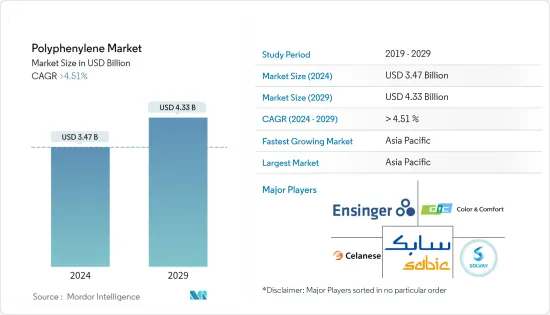
The Polyphenylene Market size is estimated at USD 3.47 billion in 2024, and is expected to reach USD 4.33 billion by 2029, growing at a CAGR of greater than 4.51% during the forecast period (2024-2029).
The polyphenylene market was negatively impacted by the COVID-19 pandemic as there was a slowdown in production and mobility, wherein industries such as electrical and electronics, transportation, and others were forced to delay their production due to containment measures and economic disruptions. Currently, the market has recovered from the pandemic. The market reached pre-pandemic levels in 2022 and is expected to grow steadily in the future.
The growing usage of polyphenylene in the electrical and electronics industry and increasing demand for hybrid electric vehicles are the factors driving the growth of the studied market.
On the flip side, the availability of substitutes and the high cost associated with polyphenylene over other conventional materials are key factors limiting the growth of the market studied.
Moreover, the emerging applications of polyphenylene in 5G circuit board is a key factor expected to act as a lucrative opportunity for the studied market.
Asia-Pacific is expected to dominate the market, with the largest consumption from China, Japan, South Korea, and India.
Polyphenylene Market Trends
Increasing Demand from Automotive and Transportation Segment
- Polyphenylene is processed into its derivatives, like polyphenylene sulfide (PPS), polyphenylene oxide (PPO), and polyphenylene ether (PPE). Polyphenylene derivatives are preferred in electric auto parts that require higher temperature stability.
- In recent years, PPS successfully replaced metal, aromatic nylons, phenolic polymers, and bulk molding compounds in various engineered vehicle components.
- Polyphenylene derivatives become the ideal choice for automotive parts exposed to high temperatures. These can provide high strength while being light in weight. These are used in vehicle components, like electrical connectors, ignition systems, lighting systems, fuel systems, hybrid vehicle inverter components, and pistons.
- According to the Organisation Internationale des Constructeurs d'Automobiles(OICA), 85.02 million vehicles were produced across the globe in 2022, witnessing a growth rate of 6% compared to 2021, thereby enhancing the demand for polyphenylene derivatives, which are employed for various automotive parts.
- China is the largest manufacturer of automobiles in the world. The country's automotive sector has been shaping up for product evolution, with the country focusing on manufacturing products to ensure fuel economy while minimizing emissions, owing to the growing environmental concerns.
- According to OICA, automobile production and sales in the country reached 27.021 million and 26.864 million, respectively, in 2022, up 3.4% and 2.1% from the previous year.
- Further, the global electric vehicle market is expanding significantly which is benefitting the market studied. For instance, in 2022, around 10.5 million units of battery electric vehicles (BEVs) and plug-in hybrid electric vehicles (PHEVs) were sold across the globe, witnessing a growth rate of 55% compared to 6.77 million units sold in the previous year.
- All factors above are likely to significantly enhance the demand for polyphenylene in the automotive and transportation segment, and thus will propel the growth of the market studied.
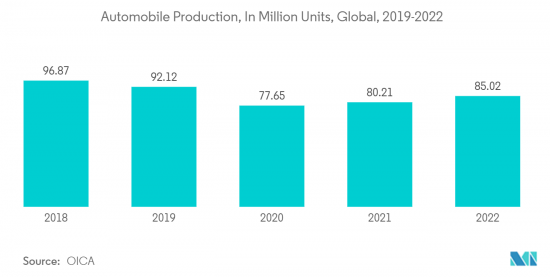
Asia-Pacific to Dominate the Market
- Asia-Pacific represents the largest market for polyphenylene. In countries like China, Japan, South Korea, and India, the demand for polyphenylene has been increasing due to growing industries like automotive and transportation and electrical and electronics.
- In the Asia-Pacific region, the governments have adopted favorable policies toward the adoption of electric vehicles and the expansion of manufacturing infrastructure for electric vehicles. This, in turn, is anticipated to provide a huge impetus to the electric vehicle market in the region during the forecast period.
- The Chinese government policy developments include the restriction of investments in new ICE-vehicle manufacturing plants and a proposal to tighten the average fuel economy of its light-duty passenger vehicle fleet by 2025.
- Increasing standards of living in Asian countries have also led to increased awareness among the people of the use of electric and hybrid vehicles.
- The Asia-Pacific region is also the dominant producer of electrical and electronics across the world, with countries such as China, Japan, South Korea, and Malaysia contributing toward it. India is also emerging as a manufacturing hub for electronic products in Asia. This established industry is expected to attract demand for polyphenylene and its derivatives from the region.
- Thus, the increasing usage and widening arena of application in the electrical and electronics industry is expected to drive market growth. In the electronics segment, Chinese manufacturers are setting up overseas production bases in order to expand in the international markets.
- For instance, In March 2023, TCL broadened its presence in international markets by establishing factories abroad, producing televisions, modules, and photovoltaic cells in Vietnam, Malaysia, Mexico, and India. In addition, it has formed partnerships with local companies in Brazil to collaboratively develop production facilities, supply chains, and an R&D infrastructure.
- Further, according to the Ministry of Electronics and Information Technology, the production value of consumer electronics (TV, accessories, and audio) across India was above INR 745 billion (USD 9.46 billion) in fiscal year 2022. Thus supporting the growth of the market.
- Moreover, as per the Japan Electronics and Information Technology Industries Association (JEITA), the domestic production by the Japanese electronics industry was estimated at JPY 11,124.3 billion (USD 85.19 billion) in 2022, witnessing a growth rate of 2% compared to the previous year.
- Thus, rising demand from the end-user mentioned above industries is expected to drive growth in the Asia-Pacific region.
Polyphenylene Industry Overview
The polyphenylene market is partially fragmented in nature. The major players in the studied market (not in any particular order) include SABIC, Ensinger, Celanese Corporation, DIC CORPORATION, and Solvay, among others.
Additional Benefits:
- The market estimate (ME) sheet in Excel format
- 3 months of analyst support
TABLE OF CONTENTS
1 INTRODUCTION
- 1.1 Study Assumptions
- 1.2 Scope of the Study
2 RESEARCH METHODOLOGY
3 EXECUTIVE SUMMARY
4 MARKET DYNAMICS
- 4.1 Drivers
- 4.1.1 Growing Usage in Electrical and Electronics Industry
- 4.1.2 Increasing Demand from Hybrid Electric Vehicles
- 4.1.3 Other Drivers
- 4.2 Restraints
- 4.2.1 Availability of Substitute
- 4.2.2 Other Restraints
- 4.3 Industry Value Chain Analysis
- 4.4 Porter's Five Forces Analysis
- 4.4.1 Bargaining Power of Suppliers
- 4.4.2 Bargaining Power of Buyers
- 4.4.3 Threat of New Entrants
- 4.4.4 Threat of Substitute Products and Services
- 4.4.5 Degree of Competition
5 MARKET SEGMENTATION (Market Size in Value)
- 5.1 Type
- 5.1.1 Polyphenylene Sulfide
- 5.1.2 Polyphenylene Oxide
- 5.1.3 Polyphenylene Ether
- 5.2 End-user Industry
- 5.2.1 Electrical and Electronics
- 5.2.2 Automotive and Transportation
- 5.2.3 Other End-user Industries (Coatings, Etc.)
- 5.3 Geography
- 5.3.1 Asia-Pacific
- 5.3.1.1 China
- 5.3.1.2 India
- 5.3.1.3 Japan
- 5.3.1.4 South Korea
- 5.3.1.5 Rest of Asia-Pacific
- 5.3.2 North America
- 5.3.2.1 United States
- 5.3.2.2 Mexico
- 5.3.2.3 Canada
- 5.3.3 Europe
- 5.3.3.1 Germany
- 5.3.3.2 United Kingdom
- 5.3.3.3 Italy
- 5.3.3.4 France
- 5.3.3.5 Rest of Europe
- 5.3.4 South America
- 5.3.4.1 Brazil
- 5.3.4.2 Argentina
- 5.3.4.3 Rest of South America
- 5.3.5 Middle East and Africa
- 5.3.5.1 Saudi Arabia
- 5.3.5.2 South Africa
- 5.3.5.3 Rest of Middle East and Africa
- 5.3.1 Asia-Pacific
6 COMPETITIVE LANDSCAPE
- 6.1 Mergers & Acquisitions, Joint Ventures, Collaborations, and Agreements
- 6.2 Market Share(%)**/Ranking Analysis
- 6.3 Strategies adopted by Leading Players
- 6.4 Company Profiles
- 6.4.1 Biesterfeld AG
- 6.4.2 Celanese Corporation
- 6.4.3 Chevron Phillips Chemical Company LLC
- 6.4.4 DIC Corporation
- 6.4.5 Emco Industrial Plastics
- 6.4.6 Ensinger
- 6.4.7 KUREHA CORPORATION
- 6.4.8 LG Chem
- 6.4.9 Mitsubishi Chemical Group of companies
- 6.4.10 Nagase America LLC
- 6.4.11 RTP Company
- 6.4.12 SABIC
- 6.4.13 Solvay
- 6.4.14 Sumitomo Bakelite Co., Ltd.
- 6.4.15 TORAY INDUSTRIES, INC.
- 6.4.16 Tosoh Europe B.V.
7 MARKET OPPORTUNITIES AND FUTURE TRENDS
- 7.1 Applications in 5G Circuit Board
- 7.2 Other Opportunities






